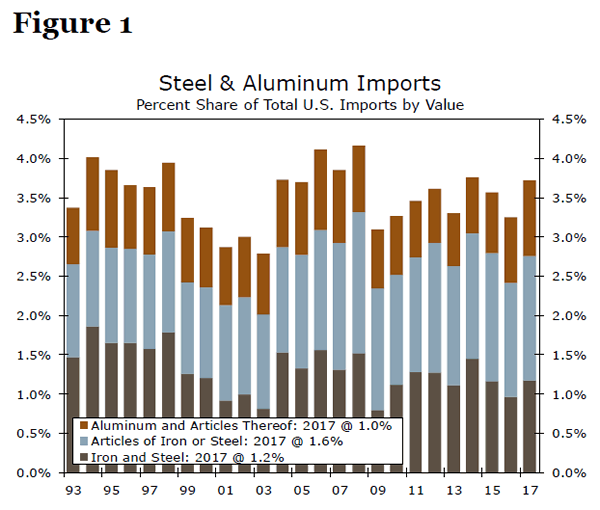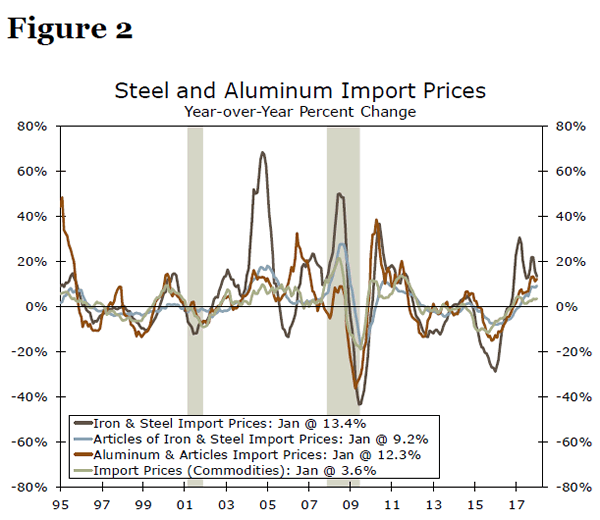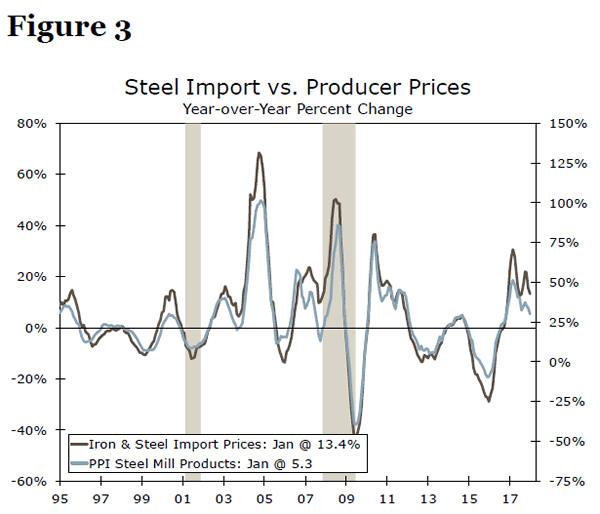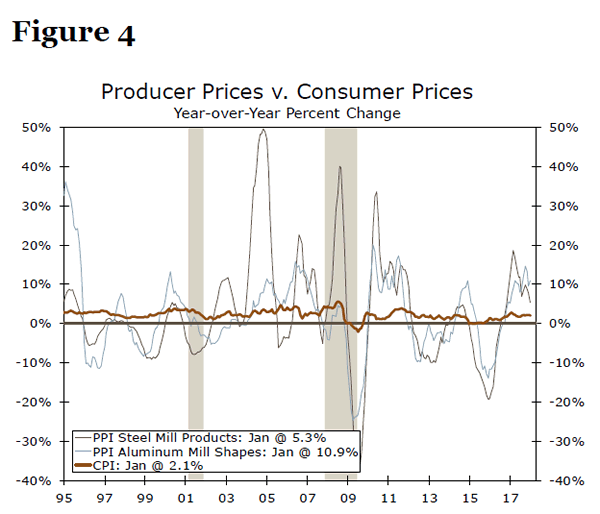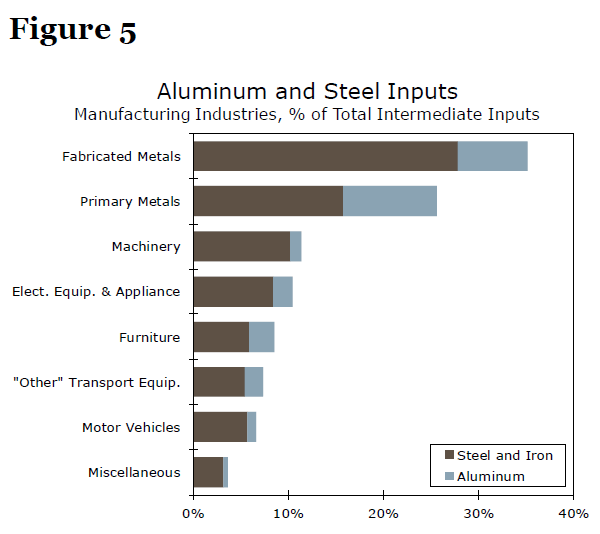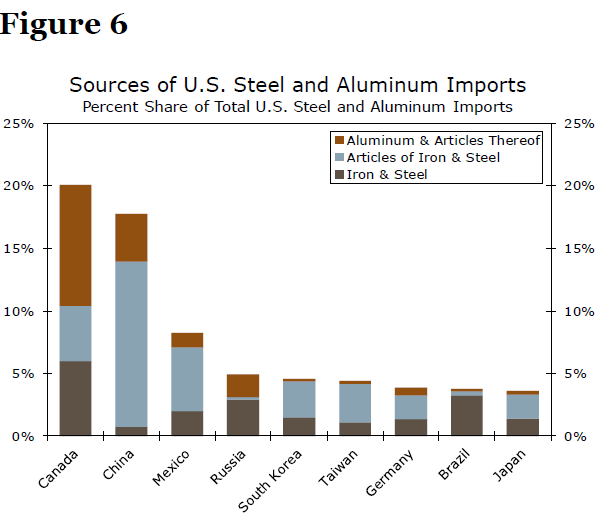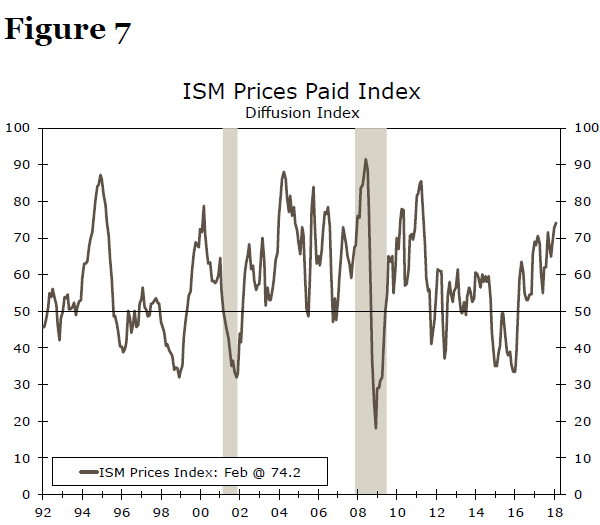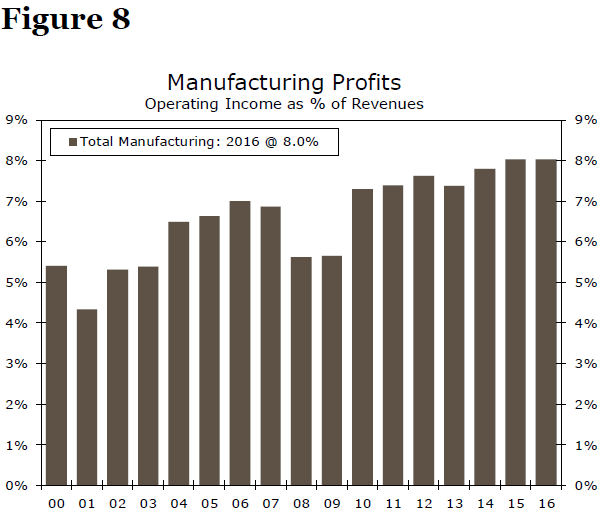Executive Summary
President Trump has announced that he intends to levy tariffs of 25 percent and 10 percent, respectively, on imports of steel and aluminum, but there is considerable uncertainty regarding the effects of these proposed tariffs on the U.S. economy. For starters, all of the details are not yet finalized. If the tariffs are ultimately implemented as envisioned, the industries that use a significant amount of steel and aluminum would clearly be most affected and prices of their products could rise markedly. However, we suspect that the effect on overall consumer price inflation in the United States would be modest at best. However, foreign countries could retaliate by leveling their own restrictions on American goods and services, which could prompt a follow-up response by the United States. The effects on U.S. CPI inflation could become more pronounced if a tit-for-tat cycle of retaliation were to commence.
Limited Pass-Through of Tariffs to Consumer Prices
President Trump announced on March 1 that he would levy a 25 percent tariff on imports of steel products and a 10 percent tariff on aluminum imports. There are a number of effects that the tariffs could have on the U.S. economy, including their implications for employment, prices and output in affected industries. Furthermore, all details of the plan have not yet been finalized. For the purposes of this report, we assume that the proposal initially outlined by the president (i.e., tariffs of 25 percent and 10 percent, respectively, on steel and aluminum imports with no exceptions to country of origin) is adopted. We also focus exclusively on the effects of the tariffs on broad measures of prices in the United States.
Let’s start by looking at the simple raw numbers. The United States imported $64.5 billion worth of iron, steel and articles thereof in 2017, which represents nearly 3 percent of all the merchandise goods that the country imported that year. In terms of aluminum and articles thereof, there was $22.7 billion worth of imports (1 percent of total merchandise imports) in 2017. The combined share of steel and aluminum therefore hovers below 4 percent of imports (Figure 1), which limits the degree to which price changes in these commodities affect overall U.S. import prices and inflation.
As shown in Figure 2, there is a fair degree of correlation between the price of imported steel and aluminum and overall import price inflation.1 Although steel and aluminum bear a relatively small weight in the import price index (2.8 percent and 0.9 percent, respectively), the contributions of these commodities to import price inflation can still change markedly as a result of large swings in prices. For instance, iron and steel contributed about 80 basis points more to year-over-year import price inflation in 2004 versus 2003, as annual price growth skyrocketed. The most substantial moves in the price of steel imports have, in recent history, been linked more to changes in demand rather than tariffs. Bush-era tariffs lifted prices by much less than China-driven demand growth in 2004. However, if steel and aluminum prices increased by the full amount of the recently-proposed tariffs (25 percent and 10 percent, respectively), this could add about 79 basis points to year-overyear import price inflation.
The effect of tariffs would not be limited to the prices of imported steel and aluminum. By design, tariffs are aimed at supporting domestic producers. Higher prices for imported products eases competitive price pressure on U.S. producers. As a result, the prices of domestically produced steel and aluminum (as measured by the producer price index) are closely correlated with import costs (Figure 3).2 In early 2003, a year after the Bush administration’s steel tariffs went into effect, prices for both imported and domestically produced steel were rising at the fastest pace in a number of years.
The ultimate pass-through to consumer price inflation, however, tends to be small after steel and aluminum get incorporated into finished products. Although there are positive correlations between producer prices for steel and aluminum and the CPI, the relationship is weaker than it is between import and producer prices (Figure 4). This is not surprising given that nearly two-thirds of CPI consists of services. For most services, the largest input cost is labor. Adding the cost of steel and aluminum according to the producer price index to our preferred model of consumer price inflation shows only a small effect. A 1 percent rise in steel inputs would raise the year-over-year rate of CPI by about 0.01 percentage point, while the impact from aluminum is not statistically significant.
Manufacturers to Bear the Brunt
That is not to say some industries won’t see significantly higher costs. A look at the detailed inputoutput tables for the United States reveals which industries bear the greatest exposure to higher steel and aluminum costs (Figure 5). Manufacturers that transform metals into intermediate or end products, or use steel and aluminum would see their production costs rise if the proposed tariffs go into effect.
Still, the pass-through to consumers, even if looking solely at goods prices should be fairly small. Even in the industries that use steel and aluminum most intensively, those metals account for less than 40 percent of costs. In other words, a sizable share of production costs come from other sources. In addition, firms are unlikely to change their selling prices with every move in input costs, as adjusting list prices can be time consuming and costly in its own right. Rather than adjusting prices fully, firms may absorb some of the costs via tighter margins.
Is This Time Different?
To some extent, we have been here previously. Steel tariffs ranging from 8 percent to 30 percent were put in place by the Bush administration from March 2002 to December 2003. Although the currently proposed 25 percent rate on steel is lower, it applies to a broader range of imports and countries. Steel imports from Canada and Mexico were exempt from the Bush-era tariffs due to NAFTA. As of this writing President Trump has indicated no such exemptions, which could lead to a more pronounced effect on prices given that Canada is the largest source of steel and aluminum imports and Mexico is the third-largest exporter to the U.S. for both products (Figure 6).
Industries that use steel and aluminum most intensively could also be more inclined to pass along the higher input costs in today’s environment where there is little if any slack left in the U.S. economy. Prior to the Trump administration’s announcement, input prices for manufacturers were already rising at the fastest pace in nearly seven years, according to the ISM index (Figure 7). On the other hand, the recent reduction in corporate tax rates, which should boost after-tax profits, may make businesses less compelled to raise prices to maintain margins. Manufacturers’ margins currently sit at a 17-year high, suggesting some scope to absorb higher input costs (Figure 8). In short, there is considerable uncertainty regarding the responses of businesses to the proposed tariff increases.
Fed Implications: Tariff Tiff or War to Come?
Should President Trump’s tariffs get implemented as proposed, we would expect to see a small rise in consumer prices. If the average price of steel inputs were to rise exactly 25 percent, then the headline CPI inflation could rise by roughly 0.2-0.3 percentage points. However, we do not expect to see a one-for-one rise between the increase in tariffs and the domestic price of steel and aluminum, and therefore suspect consumer price inflation would rise by a bit less than 0.2 percentage points.
With headline CPI currently expected to run only a touch above 2 percent, we do not foresee the steel and aluminum tariffs as something that will present a significant threat to the Fed’s inflation mandate. That could change, however, if tariff or other trade barriers (such as quotas) become more widespread. While the Fed may be willing to tolerate inflation a little above its 2 percent target for a time so inflation can “catch up” after a prolonged shortfall, an all-out trade war could spark more threatening inflation. That would put the Fed in a difficult position as inflation would be rising above the Fed’s comfort zone while real GDP growth would likely be slowing.
Conclusion
In the event that the White House applies 25 percent tariffs on steel and 10 percent tariffs on aluminum, without an ensuing trade war, we expect minimal increases to consumer price inflation. Steel and aluminum represent only about 4 percent of U.S. imports, which limits the effect on overall inflation even if producers pass on higher input costs to consumers. We suspect that CPI inflation would rise by a bit less than 0.2 percentage points as a result of the currently-proposed tariffs. This would likely not be enough to change the Fed’s path of rate hikes. However, there remains considerable uncertainty. We will be monitoring changes to the proposed legislation and international responses to see if U.S. tariffs lead to a tit-for-tat cycle of retaliation. Stay tuned.




